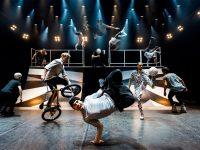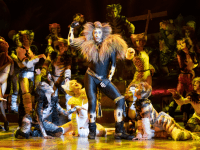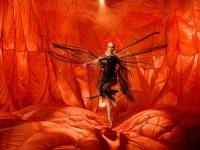
Ānanda: Dance of Joy
Experience the Elegance of Bharatanatyam as Christopher Gurusamy Dazzles Audiences
Reviewed by Brendan Daynes
Ānanda: Dance of Joy by Christopher Gurusamy offers an interesting journey through the intricate world of Bharatanatyam. This performance, meticulously crafted and elegantly presented, highlights Gurusamy’s mastery and dedication to the art form.
Exploring themes from ancient creation myths and traditional Bharatanatyam repertoire, the performance seamlessly blends the spiritual with the physical, commencing with a breathtaking depiction of primordial chaos, invoking the cosmic dance of creation. Gurusamy’s choreography, set to the evocative rägams of Lalitha and composed by Arjunan Puveendran, delves into the metaphysical origins of the universe, drawing inspiration from diverse cultural myths including those of the Yolngu people and Tamil Sangam literature. The performance artfully contrasts the narrative with precise, intricate movements, illustrating the forces that shaped existence. 
The program continued with Sami Nãn Undan Adimei, a Tamil varnam that exquisitely balances the embodiment of character with rhythmic dynamism. The narrative, centred on a devotee’s longing to experience Shiva’s dance of joy, was brought to life through Gurusamy’s eloquent choreography and the resonant musical arrangement by Arjunan Puveendran. The dancer’s exploration of desire, devotion, and dance was deeply moving, reflecting a lifelong journey intertwined with the arts.
Following the intermission, the performance featured Yãrukāgilum and Ninnu Juda, each offering a unique yet complementary perspective. Yãrukāgilum, choreographed by Bragha Bessell, depicted a spirited dialogue between a lover and societal gossip. In contrast, Ninnu Juda, a padam by Kshetrayya, expressed the joy of reunion through sensuous Telugu poetry. Bessell’s interpretation of Yãrukāgilum brought captivating narrative depth, while the dancer’s expressive movements in Ninnu Juda articulated a spectrum of human emotions from elation to longing.
The final piece, Thillana, composed by Veena Seshanna and choreographed by Gurusamy, offered a energetic conclusion to the performance. The thillana, a traditional Bharatanatyam finale, is renowned for its exuberance and rhythmic complexity. Gurusamy’s execution was a masterclass in combining melody and rhythm to create an electrifying end to the evening. His physicality—ranging from the graceful lowering into a grand plié to the rhythmic stamping of feet—demonstrated both strength and finesse, mesmerising the audience with its visual and auditory allure.
Visually, the performance was enhanced by costumes that were both culturally specific and aesthetically splendid, adorned with traditional ankle bells known as “kattai.” These details, along with the evocative lighting design, created an immersive atmosphere that enriched the overall experience.
Witnessing Ānanda: Dance of Joy was a privilege and an enlightening experience. While my personal connection to Bharatanatyam is limited, Gurusamy’s prowess as a performer and choreographer was unmistakable. The intricacies of his movements, the precision of his execution, and the depth of his emotional expression were truly impressive. The performance was not only a showcase of technical brilliance but also a rich cultural lesson that resonated deeply.
Ānanda: Dance of Joy played at the DanceHouse from July 25 to 27 2024. For more information on the show please visit https://www.dancehouse.com.au/whats-on/ananda-dance-of-joy/









